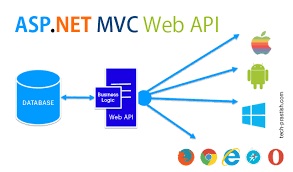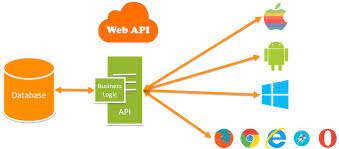In this article, I am going to discuss the Media Type Formatter in Web API with examples. Please read our previous article before proceeding to this article where we discussed Content Negotiation in Web API. As part of this article, we are going to discuss the following important concepts.

- What are MediaTypeFormatters in Web API?
- How to retrieve the Built-in Media Type Formatters in ASP.NET Web API?
- Example of Media Type Formatters.
- Understanding MediaTypeFormatter classes in ASP.NET Web API?
- How to return the data in JSON format from Web API Service irrespective of the Accept header value?
- How to return the data in XML format from Web API Service irrespective of the Accept header value?
- Return JSON instead of XML from ASP.NET Web API Service when a request is made from the browser?
Note: We are going to work with the same example that we started in Video. So please read that Video before proceeding to this Video.
What are MediaTypeFormatters in ASP.NET Web API?
As we have discussed in our previous Video that the Web API Framework handles the JSON and XML data based on the Accept and Content-Type headers. But, the important question is how does it handle these different formats? The answer is By using Media-Type formatters.
The Media type formatters are the classes that are responsible for serializing the request/response data so that the Web API Framework can understand the request data format and also send data in the format which the client expects. ASP.NET Web API includes the following built-in media type formatters.

How to Retrieve the Built-in Media Type Formatters in ASP.NET Web API?
The Web API Framework includes the above-listed media type formatter classes by default. However, you can also add, remove or change the order of the formatters. The following example demonstrates an HTTP Get method that returns all built-in formatter classes.
In the above example, the GlobalConfiguration.Configuration.Formatters returns the MediaTypeFormatterCollection that includes all the formatter classes. The above example returns the names of all the formatter classes as shown in the image below.

Alternatively, the MediaTypeFormatterCollection class defines convenience properties that provide direct access to three of the four built-in media type formatters. The following example shows retrieving the media type formatters using MediaTypeFormatterCollections properties.
The above example returns the following response to the browser.

Understanding Media Type Formatters in ASP.NET Web API:
Let us understand Media Type Formatters in ASP.NET Web API with an example. From the ASP.NET Web API perspective, serialization is the process of translating a .NET type into a format that can be transmitted over HTTP. The default format in Web API can be either JSON or XML. A media type formatter that is an object of type MediaTypeFormatter, performs the serialization in the ASP.NET Web API pipeline. To understand this, please have a look at the following action method. The following action method returning an Employee object.
The above method returns a CLR object of Employee type. In order to return the data contained in the Employee object to the client, the Employee object needs to be serialized. The serialization in the ASP.NET Web API application is generally performed by the MediaTypeFormatter.
The Web API Media Type Formatters serializes the object which is going to be returned from the action method into either JSON or XML based on the Accept header value of the HTTP Request. Once the ASP.NET Web API Media Type Formatters serializes the data into XML or JSON then these JSON or XML data are written into the response message body.
The ASP.NET Web API media type formatters that serialize the object into the JSON and XML are JsonMediaTypeFormatter and XmlMediaTypeFormatter respectively. Both the classes are deriving from MediaTypeFormatter class. The process through which the MediaTypeFormatter is chosen is called content negotiation which we discussed in our previous Video in detail.
What is ASP.NET Web API MediaTypeFormatter?
The ASP.NET Web API MediaTypeFormatter is an abstract class from which the JsonMediaTypeFormatter and XmlMediaTypeFormatter classes are inherited. The JsonMediaTypeFormatter handles the JSON request and response where the XmlMediaTypeFormatter handles the XML request and response.
A resource can have one or more representations. When we issue a GET request to retrieve a resource, such as an employee with ID 1, the response message contains the representation of the resource, for example, any value that specific action returns. The Web API indicates how the resource is represented in the response through the Content-Type response header. The Accept request header can be used by a client to indicate the set of preferred representations for the resource in the response.
By default, the Web API framework supports two media types: JSON and XML. When you issue a request with Accept: application/json, then the response message will be JSON and the Content-Type will be set to application/json. Similarly, if you issue a request with Accept: application/xml, then the response message will be XML and the Content-Type will be set to application/xml.
You can also specify a quality value indicating the relative preference. The range is 0–1, with 0 being unacceptable and 1 being the most preferred. The default value is 1. For example, consider the below header
Accept: application/json; q=0.8, application/xml;q=0.9
Here, the response message will be in XML format because the application/xml has a quality value of 0.9, which is higher than the quality value of 0.8 specified for application/json.
How to return data in JSON format from Web API Service irrespective of Accept header value?
To return data in JSON format from Web API service irrespective of accept header value, we need to include the following line in Register() method of WebApiConfig.cs file in the App_Start folder. The following line of code completely removes the XmlFormatter which forces ASP.NET Web API Framework to always return data in JSON format irrespective of the Accept header value in the client request. Use this technique when you want your service to support only JSON and not XML.
config.Formatters.Remove(config.Formatters.XmlFormatter);
How to return data in XML format from Web API Service irrespective of Accept header value?
To return data in XML format from Web API service irrespective of accept header value, we need to include the following line in the Register() method of WebApiConfig.cs file in the App_Start folder. The following line of code completely removes the JsonFormatter which forces ASP.NET Web API Framework to always return data in XML format irrespective of the Accept header value in the client request. Use this technique when you want your service to support only XML and not JSON.
config.Formatters.Remove(config.Formatters.JsonFormatter);
How to return JSON instead of XML from ASP.NET Web API Service when a request is made from the browser?
So here is what we want the service to do
- When a request is issued from the browser, the web API service should return JSON instead of XML.
- When a request is issued from a tool like a fiddler the Accept header value should be respected. This means if the Accept header is set to application/xml the service should return XML and if it is set to application/JSON the service should return JSON.
There are 2 ways to achieve this
Approach 1: Include the following line in Register() method of WebApiConfig.cs file in the App_Start folder. This tells ASP.NET Web API to use JsonFormatter when a request is made for text/html which is the default for most browsers. The problem with this approach is that the Content-Type header of the response is set to text/html which is misleading.
config.Formatters.JsonFormatter.SupportedMediaTypes.Add(new MediaTypeHeaderValue(“text/htmlâ€));
Approach 2: Include the following class in WebApiConfig.cs file in the App_Start folder.
Register Custom formatter in ASP.NET Web API.
Place the following line in the Register() method of WebApiConfig.cs file in the App_Start folder.
config.Formatters.Add(new CustomJsonFormatter());
With these 2 changes, when a request is issued from the browser we will get JSON formatted data and the Content-Type header of the response is also set to application/json. If we are using tools like Fiddler and if we set Accept header to application/xml we will still get XML formatted data.
 Best resource for Online free Education
Best resource for Online free Education
